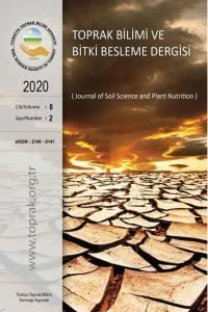Domates üretim atık ve artıklarından kompost eldesi
Kompost, domates artık ve atıkları, windrow, C/N
Composting of the post-harvested tomato plant wastes and residues
Compost, tomato waste and residues, windrow, C/N,
___
- Alagöz Z, Yılmaz E, Öktüren F, 2006. Organik materyal ilavesinin bazı fiziksel ve kimyasal toprak özellikleri üzerine etkileri. Akdeniz Üniversitesi Ziraat Fakültesi Dergisi 19(2): 245-254.
- Anderson J P E, Domsch K H, 1978. A physiological method for the quantative measurement of microbial biomass in soils. Soil Biology and Biochemistry 10: 215 – 221.
- Bernal M P, Alburquerque J A, Moral R, 2009. Composting of animal manures and chemical criteria for compost maturity assessment. A review. Bioresource Technology 100: 5444–5453.
- Bilen S, Sezen Y, 1993. Toprak reaksiyonunun bitki besin elementleri elverişliliği üzerine etkisi. Atatürk Üniv. Zir. Fak. Der. 24 (2): 156-166.
- De Bertoldi M, Vallini G, Pera A, 1983. The biology of composting: a review. Waste Manage. Res. 1: 157–176.
- D'Hose T, Cougnon M, De Vliegher A, Willekens K, Van Bockstaele E, Reheul D, 2012. Farm compost application: effects on crop performance. Compost Science & Utilization 20 (1): 49-56.
- Fernandes F, Viel M, Sayag D, André L, 1988. Microbial Breakdown of Fats Through In- Vessel Co-composting of Agricultural and Urban Wastes. Biological Wastes. 26: 33-48.
- Gray K R, Sherman K, 1969. Accelerated Composting of Organic Wastes. Birmingham University Chemical Engineering. 19-21, 3, 1968-70: 64-70.-Birmingham, England.
- Gülser C, Candemir F, Kanel Y, Demirkaya S, 2015. Effect of manure on organic carbon content and fractal dimensions of aggregates. Eurasian Journal of Soil Science 4(1): 1-5.
- Haynes R J, Naidu R, 1998. Influence of lime, fertilizer and manure applications on soil organic matter content and soil physical conditions: a review. Nutrient Cycling in Agroecosystems. 51: 123–137.
- Kacar B, Kütük C, 2010. Gübre Analizleri. Nobel Yayın No.1497, 382 s. Nobel Basımevi, Ankara Moreno Casco J, Moral Herrero R, 2008. Compostaje (eds. Moreno Casco J, Moral Herrero R). Ediciones Mundi-Prensa, Madrid-Barcelona-Mexico. pp. 1-570.
- Nielsen H, Berthelsen L, 2002. A Model for Temperature Dependency of Thermophilic Composting Process Rate. Compost Science & Utilization. 10 (3): 249-257.
- Iqbal M K, Shafiq T, Ahmed K, 2010. Effect of different techniques of composting on stability and maturity of municipal solid waste compost. Environmental Technology. 31 (2): 205–214.
- Kürklü A, Bilgin S, Külcü R, Yaldız O, 2004. Bazı Sera Bitkisel Biyokütle Atıklarının Miktar ve Enerji İçeriklerinin Belirlenmesi Üzerine Bir Araştırma. Biyoenerji 2004 Sempozyumu, 2004, İzmir.
- Poincelot R P, 1972. The Biochemestry and Methodology of Composting. Connecticut Agriculture Experiment Station Bulletin 727: 38.
- Ryan J, Estefan G, Rashid A, 2001. Soil and plant analysis laboratory manual. International Center for Agricultural Research in the Dry Areas (ICARDA). Syria
- Sundberg C, Smars S, Jönsson H, 2004. Low pH as an inhibiting factor in the transition from mesophilic to thermophilic phase in composting. Bioresource Technology. 95: 145–150.
- Shimizu N, 2017. Process Optimization of Composting Systems. In: Robotics and Mechatronics for Agriculture (eds. Dan Zhang, Bin Wei). CRC Press Taylor & Francis Group 6000 Broken Sound Parkway NW, Suite 300 Boca Raton, FL 33487-2742, pp. 1-22.
- TÜİK 2017. Bitkisel üretim istatistikleri. https://biruni.tuik.gov.tr/medas/?kn=92&locale=tr,
- Xi B D, Meng W, Huang G H, Liu H L, Zeng G M, Yuan X Z, Wang Q, Bai Q Z, 2003.Composting technology of municipal solid waste with inoculation agent. J. Environ. Sciences-China 24 (1): 157–160.
- Zucconi F, de Bertoldi M, 1987. Compost specifications for the production and characterization of compost from municipal solid waste. In Compost: production, qualitv and use, ed. M. de Bertoldi, M. P. Ferranti, P. L’Hermite, F. Zucconi. Elsevier Applied Science, Essex, 30-50.
- ISSN: 2146-8141
- Yayın Aralığı: 2
- Başlangıç: 2012
- Yayıncı: Türkiye Toprak Bilimi Derneği
Boussinesq denkleminin çözümüne bağlı olarak taban suyu seviyesi yüksekliğinin incelenmesi
İmanverdi EKBERLİ, Coşkun GÜLSER
Ferruh Feza YILMAZ, Duygu Boyraz ERDEM
Biyokömür ve vermikompost uygulamalarının toprağın bazı biyolojik özellikleri üzerine etkisi
Funda Irmak YILMAZ, Safiye KURT
Domates üretim atık ve artıklarından kompost eldesi
Murat DURMUŞ, Rıdvan KIZILKAYA
Elma ve gül posası biyoçarlarının kumlu toprağın bazı fiziksel özellikleri üzerine etkileri
Pelin ALABOZ, Ahmet Ali IŞILDAR
Bahadır ATMACA, Hafize NALBANT
Çay çöpü kompostu ve tuz uygulamalarının biber bitkisinin gelişimine etkileri
Bender Damla ÖZENÇ, Demirhan HUT
Silisyumun bitki gelişimine olan etkileri
Mehmet Burak TAŞKIN, Ferhat TÜRKMEN, Muhittin ONUR AKÇA, Mahmut Reşat SOBA, Hasan Sabri ÖZTÜRK
